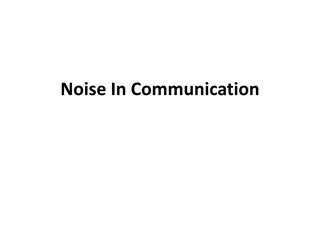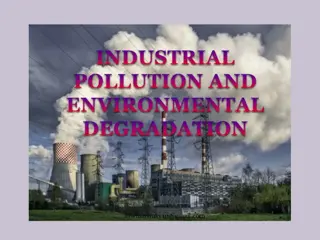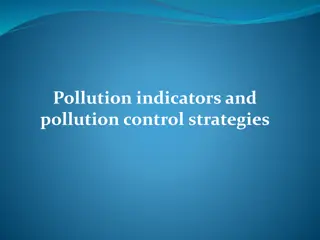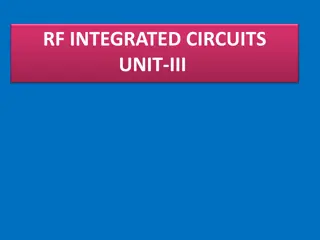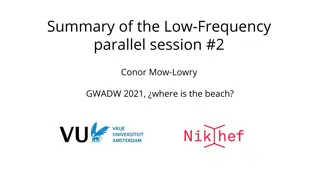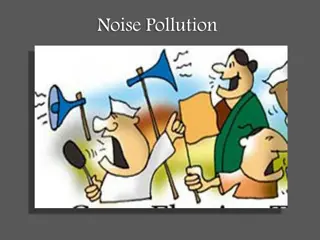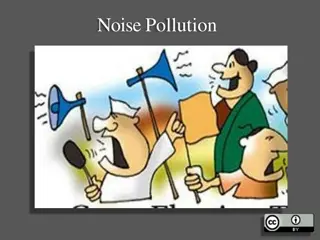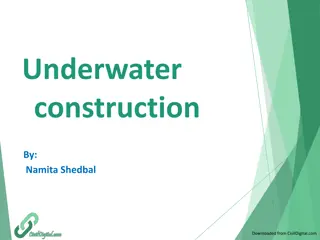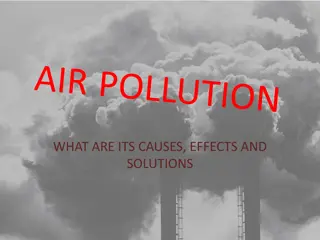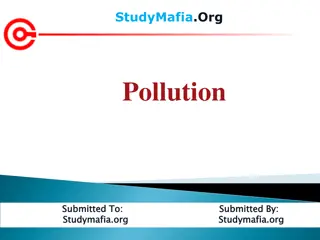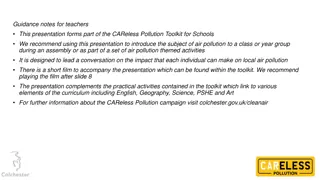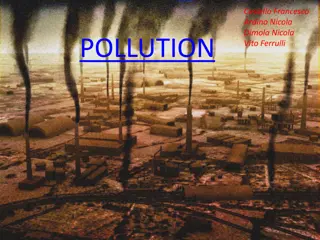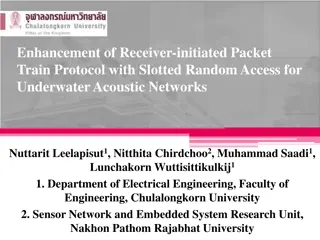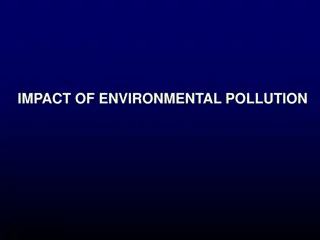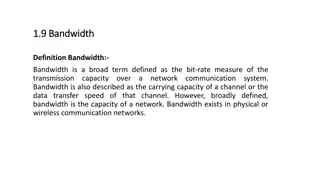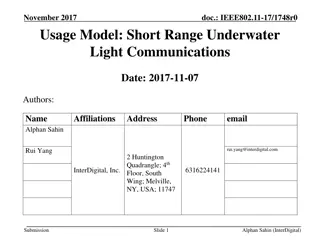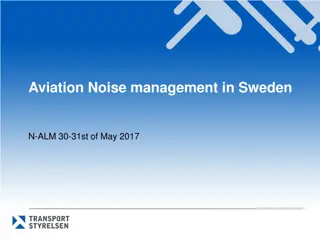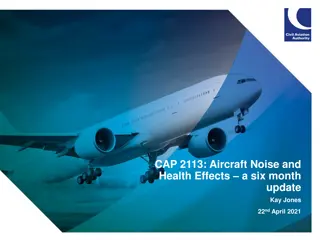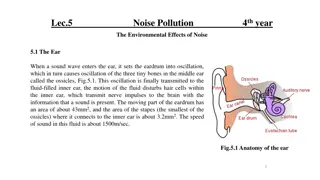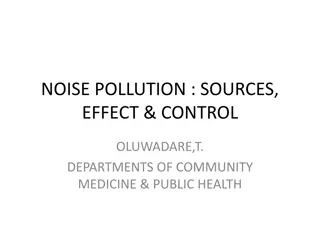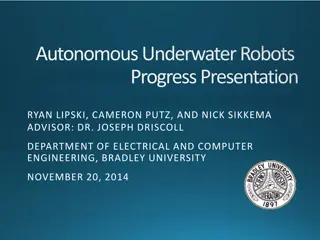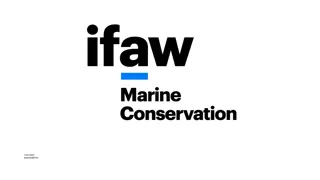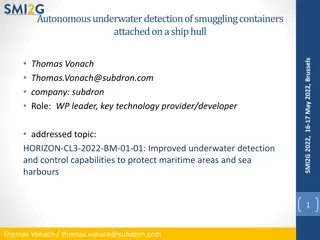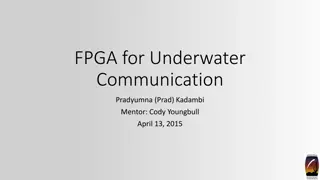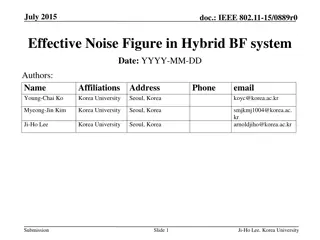Underwater Backscatter Channel: Theory, Link Budget, and Climate Monitoring
In response to the significant impacts of climate change on the world's oceans, a new technology called underwater backscatter is being developed for distributed ultra-low-power underwater sensor networks. This technology aims to enable climate monitoring, sea-level measurement, and hurricane respon
3 views • 18 slides
Understanding Frequency Weighting in Noise Pollution Measurement
Frequency weighting is essential in noise pollution measurement to reflect how the human ear perceives noise. The A, C, and Z weightings are commonly used to represent different frequency responses. A-weighting covers the audible frequencies where the human ear is most sensitive, while C-weighting i
2 views • 7 slides
Understanding Noise in Communication Systems
Noise in communication refers to unwanted energy that interferes with signal reception and transmission. It can be categorized as external or internal noise, each with various subtypes like atmospheric noise and shot noise. Recognizing and managing different types of noise is essential for ensuring
1 views • 8 slides
Understanding Different Types of Pollution and Ways to Combat Them
Pollution comes in various forms such as water, noise, air, thermal, and land pollution. Each type has specific sources and impacts. Air pollution, caused by industrial activities and burning of fossil fuels, emits harmful substances into the air. Water pollution occurs due to the discharge of chemi
0 views • 13 slides
Advancements in Air Pollution Prediction Models for Urban Centers
Efficient air pollution monitoring and prediction models are essential due to the increasing urbanization trend. This research aims to develop novel attention-based long-short term memory models for accurate air pollution prediction. By leveraging machine learning and deep learning approaches, the s
0 views • 17 slides
Understanding Environmental Hygiene: Air Pollution and Composition of Air
The content delves into the concept of atmospheric pollution, the composition of pure and impure air, sources of air pollution, and the zones of the atmosphere. It highlights the detrimental effects of pollutants on health and the environment, emphasizing the importance of environmental hygiene. The
1 views • 27 slides
Understanding Pollution: Indicators and Control Strategies
Pollution is a significant environmental issue, yet often misunderstood. This article delves into the definition of pollution, classification, and considerations for effective pollution control strategies. It discusses the UK Environmental Protection Act of 1990, pollutant properties, toxicity, and
2 views • 50 slides
Understanding Air Pollution and Its Impact on Health and Environment
Air pollution poses a significant threat to human health, the environment, and the economy. The Clean Air Act has played a crucial role in reducing air pollutants since its establishment in 1963. Criteria air pollutants such as ozone, particle pollution, carbon monoxide, lead, sulfur dioxide, and ni
1 views • 11 slides
Understanding Noise in RF Integrated Circuits: Thermal and 1/f Noise
Noise, an unwanted input, limits a system's ability to process weak signals. Sources of noise include random noise in resistors and transistors, mixer noise, undesired cross-coupling noise, and power supply noise. Thermal noise, caused by thermal agitation of charge carriers, is also known as Johnso
1 views • 49 slides
Comprehensive Environmental Chemistry Open Course Overview
This open course offered by the Department of Chemistry covers various aspects of environmental chemistry, including air and water pollution, soil pollution, noise pollution, thermal pollution, and radioactive pollution. Students will learn about the causes and effects of different types of pollutio
3 views • 9 slides
Insights from ET-ISB Workshop on Low-Frequency Noise and GWADW 2021
The ET Instrument Science Board held a workshop focusing on addressing key challenges related to low-frequency noise in gravitational wave detectors. Experts discussed topics such as mirror temperature, dealing with low-frequency noise realities, and facility limits. The workshop highlighted the sig
0 views • 13 slides
Advanced Understanding of Low-Frequency Noise in Instrumentation
Understanding low-frequency noise in instrumentation has advanced significantly, emphasizing the need for an integrated approach to predict and mitigate such noise. Recent studies show that low-frequency noise in third-generation instruments is exceptionally better than in second-generation detector
0 views • 11 slides
Understanding Noise in Communication Systems
Noise in communication systems refers to unwanted signals that interfere with desired signals, originating from various sources such as interference from human-made sources and naturally occurring random noise. This noise can arise from factors like cross talk, power supplies, ignition systems, and
0 views • 19 slides
Understanding Noise Pollution: Causes, Effects, and Control Measures
Undesired or excessive sound, known as noise pollution, can have harmful effects on human health, wildlife, and the environment. It is caused by various sources such as industries, workplaces, highways, railways, and airplanes. Sound waves, measured in decibels, play a crucial role in determining th
3 views • 17 slides
Understanding Noise Pollution: Sources, Terminology, and Measurement
Noise pollution is defined as undesirable sounds that disrupt human and animal life. This article explores the sources of noise pollution, terminology used in its measurement, and its impact on urban environments. Major sources include traffic noise, industrial machinery, and household activities. U
1 views • 26 slides
Understanding Noise Pollution and Mechanism of Hearing
Noise pollution is defined as unwanted human or machine-created noise that disrupts daily life. This term is explained along with terminology related to frequency and intensity of sound in this informative content. Additionally, the mechanism of hearing is detailed, describing how sound waves are pr
0 views • 34 slides
Understanding the Impact of Noise Pollution on Health and Environment
Noise pollution is a prevalent issue affecting our health and environment. It includes unwanted sound that disrupts daily activities, leading to various health problems like hearing loss, high blood pressure, stress, and more. This pollution stems from both outdoor sources like construction and road
0 views • 27 slides
Understanding Noise Pollution and Its Adverse Health Effects
Noise pollution is the unwanted sound that disrupts daily activities, impacting human well-being. It can lead to health issues like high blood pressure, stress-related illnesses, sleep disturbance, and hearing loss. Despite being invisible, its effects are significant and can cause memory loss, depr
2 views • 21 slides
Understanding Noise Control Methods in Environmental Engineering
Explore the concepts of noise control in environmental engineering, focusing on mufflers, reactive mufflers, and noise control in the transmission path. Learn about absorptive and reactive mufflers, their principles, and applications. Discover how barriers and panels can effectively reduce noise tra
0 views • 9 slides
Techniques and Structures for Underwater Construction
Underwater construction involves unique challenges due to working in water, requiring methods like caissons and cofferdams. Caissons are water-tight structures used for various constructions, while cofferdams create dry enclosures for building operations underwater. Different types of caissons and c
0 views • 11 slides
POLLUTION PREVENTION: A Closer Look at Environmental Initiatives in Oklahoma
Explore the evolution and implementation of pollution prevention measures in Oklahoma, focusing on statutory directives, recent activities, recycling efforts, tax credits, and more. The Pollution Prevention Act of 1990 plays a crucial role in reducing environmental hazards through the reduction of p
0 views • 31 slides
Understanding Air Pollution: Causes, Effects, and Solutions
Pollution is the harmful introduction of contaminants into the environment, caused by human activities and natural disasters. It impacts all living organisms, making it challenging to sustain life. Air pollution, a major form of pollution, occurs when pollutants such as gases, dust particles, and fu
0 views • 8 slides
Understanding Pollution: Types, Causes, and Impacts
Pollution is the introduction of harmful substances or energy into the environment, leading to adverse changes in living entities. It can be caused by various factors such as chemical pollutants and energy forms like sound and light. This article discusses different types of pollution including air,
0 views • 25 slides
Addressing Air Pollution in Schools: A Presentation and Toolkit Overview
Introduction to air pollution using a presentation from the CAReless Pollution Toolkit for Schools. Covers what air pollution is, its causes, and the specific impact on areas like Colchester and schools. Aimed at starting a conversation on individual actions to combat local air pollution, complement
0 views • 16 slides
Drawbacks of City Living: Traffic Jams, Pollution, and Overcrowding
Living in a city presents several challenges including traffic jams due to increasing population, pollution affecting health and the environment, and noise pollution from construction activities. These factors make city life difficult for residents. The content discusses the drawbacks of city living
2 views • 8 slides
Understanding Noise Pollution: Causes, Effects, and Solutions
Pollution is the introduction of contaminants into the environment, with noise pollution being a major concern impacting human health and well-being. This article discusses the causes, effects, and solutions of noise pollution, highlighting the importance of addressing this environmental issue for a
0 views • 7 slides
Enhancing Receiver-Initiated Packet Train Protocol for Underwater Acoustic Networks
This study focuses on enhancing the Receiver-Initiated Packet Train Protocol with Slotted Random Access for Underwater Acoustic Networks. The research explores the challenges of underwater communication, the characteristics of underwater sensor networks, and the RIPT protocol along with its improvem
0 views • 17 slides
Understanding the Impact of Environmental Pollution
Environmental pollution, caused by the introduction of contaminants into the air, water, and soil, has detrimental effects on ecosystems and human health. This pollution includes air pollution from various sources like combustion and industrial processes, leading to the formation of harmful pollutan
0 views • 61 slides
Understanding Bandwidth, Channel Capacity, and Noise in Communication Networks
Bandwidth is a crucial aspect of network capacity, describing the data transfer speed and carrying capacity of a channel. Channel capacity involves factors like data rate, bandwidth, noise, and error rate. Noise sources include thermal noise, impulse noise, and delay distortion, impacting signal qua
0 views • 5 slides
Underwater Light Communications in November 2017
Discusses the advantages of light communications (LC) for underwater use, such as high data rate, low latency, and cost-effectiveness. Contrasts LC with acoustic and RF methods, highlighting benefits and limitations. Explores use cases including communication between submarines, divers, oil platform
0 views • 5 slides
Aviation Noise Management Strategies in Sweden
Aviation noise management in Sweden focuses on a balanced approach with four principal elements: noise reduction at the source, adherence to ICAO noise standards, differentiated landing fees, and operating restrictions. Competent authorities such as the Swedish Environmental Protection Agency and Sw
1 views • 4 slides
Understanding the Impact of Aircraft Noise on Health - Recent Update
This report provides a six-month update on recent research findings regarding aircraft noise and its effects on health. Saucy et al. studied the association between aircraft noise exposure and cardiovascular mortality, particularly at night, with significant findings related to increased odds of nig
0 views • 20 slides
Environmental Effects of Noise Pollution on Human Health
When a sound wave enters the ear, it sets off a chain reaction that can lead to various health issues such as depression, fatigue, insomnia, and decreased cognitive function. Noise pollution affects individuals at different levels - auditory, biological, and behavioral, impacting performance, physio
0 views • 15 slides
Understanding Noise Pollution: Sources, Effects, and Control
Noise pollution is a significant environmental issue resulting from unwanted sounds in various settings. This article delves into the properties of sound, measurement techniques, sources of noise, effects of noise exposure, and strategies for control and mitigation, shedding light on the impact of n
0 views • 16 slides
Progress Presentation of Autonomous Underwater Robots
This presentation showcases the progress made by a team in developing autonomous underwater robots at Bradley University. The project objectives include mapping underwater terrain, navigating a swarm of UAVs, obstacle avoidance, and generating final images. The presentation covers system block diagr
0 views • 42 slides
Addressing Underwater Noise Pollution in EU Waters: Urgent Action Needed
Whales, dolphins, and other marine life are severely impacted by underwater noise pollution caused primarily by shipping activities in EU waters. Urgent implementation of stricter regulations based on IMO guidelines is essential to reduce noise levels and protect marine ecosystems. Recommendations i
0 views • 4 slides
Autonomous Underwater Detection of Smuggling Containers for Maritime Security
Innovative project led by Thomas Vonach of Subdron focusing on enhancing underwater detection capabilities to protect maritime areas and sea harbors. Utilizing Autonomous Underwater Vehicles (AUVs), the project aims to autonomously detect illegal obstacles such as cylindrical containers attached und
0 views • 4 slides
FPGA for Underwater Communication Project Overview
This project, led by Pradyumna (Prad) Kadambi with mentor Cody Youngbull, aims to develop a robust high-speed underwater communication system using Field Programmable Gate Arrays (FPGA). The project addresses the slow and cumbersome nature of current underwater communication methods, with a focus on
0 views • 9 slides
Quadro Control for Underwater Mobile Robot Navigation Presenter
Explore the Quadro Control concept for underwater mobile robot and remote operated underwater vehicles. The hardware architecture, motor controller, propeller configuration, and prototype are discussed in detail by authors M. Firdaus, D. Hazry, A. Zul Azfar, M. Zahiruddin, and A. H. M. Nur Isamuddin
0 views • 6 slides
Noise Figure Analysis in Hybrid Beamforming Systems
This document discusses the theoretical study of noise figure (NF) and gain in hybrid beamforming systems, focusing on the impact of additional RF blocks, such as phase shifters and combiners, on noise figure calculations. It explains how the received signals from multiple antennas are phase-correct
0 views • 11 slides


